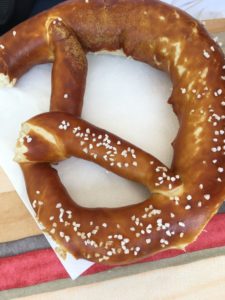Eating out is major social activity in Germany. But warning – do not eat out if you have things to do! The typical 30-45 minute activity in the United States is actually prolonged to 1-2 hours! Once you sit down at a restaurant table, that table is yours for the evening.
At home, I work as a waitress so naturally dining was one of the first significant cultural differences I noticed between the United States and Germany. American waiters and waitresses are instructed to keep the customers coming and going at a rapid pace, continually checking to see if customers need anything else to eat or the bill. But in Germany, it is completely the opposite. German waiters and waitresses rarely check on their customers, unless their customers signal them with a wave to come over. I really enjoy this philosophy of dining because it enhances the purpose of eating out: to enjoy good conversation with family and friends in a fun, vibrant atmosphere.
Each region of Germany has its own traditional food. I am currently living in the Swabia region on the borders of counties Baden-Württemberg and Bavaria in Southern Germany (see map below). The three major traditional foods of Swabia are Maultaschen, Käsespätzle, and the Swabian Brezeln.
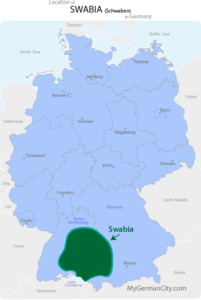
Maultaschen (Aka. “Fooling the Dear Lord”!)
There’s a reason another name for Maultaschen is “Herrgottsb’ scheisserle” or “Fooling the Dear Lord”! Legend has it that the Roman Catholic Cistercian monks of Maulbronn Monastery of western Swabia received a large gift of meat during the famine of early 17th century.
Unfortunately, they received this gift during Lent, the Catholic 40-day fast when meat is forbidden from consumption. However, the Maulbronn Monastery cook did not want to waste such a large portion of meat, so the cook ground the meat,
mixed in herbs and spinach, and wrapped small portions of this meat in dough to conceal the sinful act of meat-eating during Lent from God.
In Schwäbisch Hall, almost every restaurant offers Maultaschen. It is a local and traditional favorite, very filling, easy to make, and tastes great (tested and confirmed)! If you would like to make Maultaschen, here are the ingredients:
Pasta:
3 eggs
4 tablespoons water
1 teaspoon salt
4 cups flour
Filling:
1 pound spinach, cooked, chopped, and drained
1 cup cooked ground pork
1 onion, grated
4 slices white bread with crust
1/2 cup milk or water
salt and pepper to taste
pinch nutmeg
4 eggs
1 egg yolk beaten with 1 teaspoon water
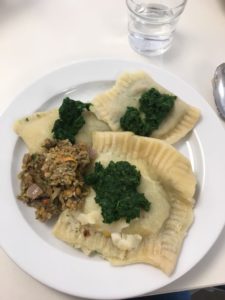
Käsespätzle – “Schwäbisch Mac and Cheese”
Homemade German egg noodles, rich Emmentaler Swiss cheese, topped with caramelized onions?! For generations, Swabians have said, “Yes, please!” Since it is such a popular dish here in Schwäbisch Hall, I decided to enroll in a class to learn how to make it. This Swabian specialty has relatively few ingredients, but it does require some muscle power to make!
First, melt 6 tablespoons of butter in a pan and add two chopped, large onions. Let them rest for 20-30 minutes, stirring occasionally. The onions should be brown when ready. While the onions are cooking, the German egg noodles (Spätzle) can be made. To make Spätzle, you will need following ingredients: plain flour, eggs, butter, salt, and water. Instead of kneading the dough, it is stirred until holes in the dough are visible. Then, place the dough, portion by portion, into a Spätzle press (yes, there is such a thing!) over a pot of boiling water and pump the dough through the Spätzle press into the boiling water below. This press creates the short, thick noodles characteristic of Spätzle. Then, let the noodles boil for several minutes.
Next, add one third of the Spätzle to an empty dish, grate one third of Emmentaler Swiss cheese on the Spätzle, and then one third of the caramelized onions. Repeat this process until all Spätzle, cheese, and onions are in the dish. And just like that, your Käsespätzle is ready!
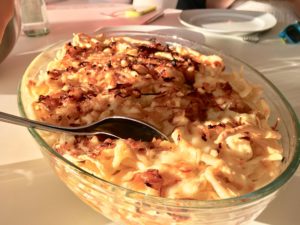
Swabian Brezeln vs. Bavarian Brezeln
Germans love bread. In Schwäbisch Hall alone, there is a bakery or cafe on almost every street and almost all have Swabian pretzels. Recently, a few other Goethe students and I went to a bakery in town to learn how to make Swabian Brezeln or Pretzels. This bakery, Bäckerei Renner, has been owned and operated by the same family in Schwäbisch Hall for 143 years! What a great family tradition!
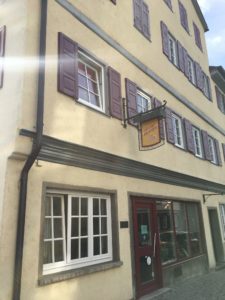
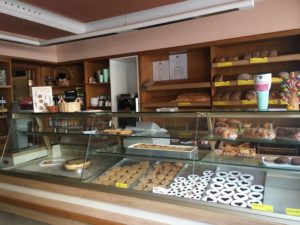
Swabian pretzels are almost the same as Bavarian pretzels. The only differences are that the ends of Bavarian pretzels are thick, whereas the ends of Swabian are skinny and Bavarians use only lard to make their Brezeln, whereas Swabians use lard and butter, making the Swabian pretzel much fattier.
Although both pretzels can be eaten alone, Bavarians prefer to eat their pretzels in with Weißwurst (veal sausage) and mustard, while Swabians typically slice their pretzels like a bagel and spread butter on them.

